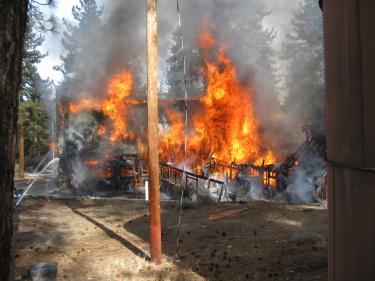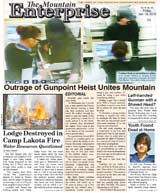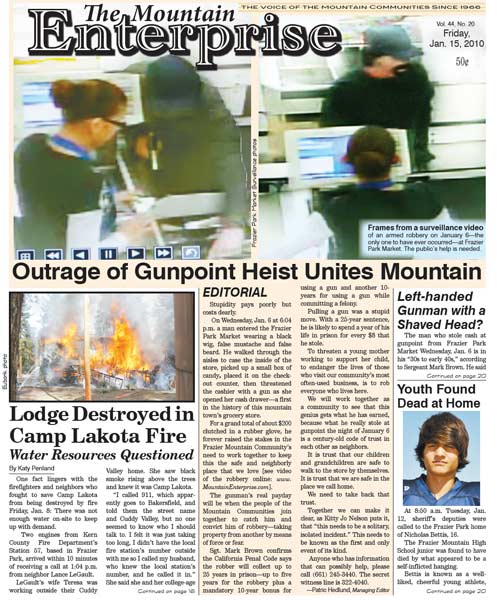
Don Eubank's photo of the Camp Lakota lodge fully involved in flames.
Water Resources Questioned
By Katy Penland
One fact lingers with the firefighters and neighbors who fought to save Camp Lakota from being destroyed by fire Friday, Jan. 8: There was not enough water on-site to keep up with demand.
Two engines from Kern County Fire Department’s Station 57, based in Frazier Park, arrived within 10 minutes of receiving a call at 1:04 p.m. from neighbor Lance LeGault.
LeGault’s wife Teresa was working outside their Cuddy Valley home. She saw black smoke rising above the trees and knew it was Camp Lakota.
“I called 911, which apparently goes to Bakersfield, and told them the street name and Cuddy Valley, but no one seemed to know who I should talk to. I felt it was just taking too long, I didn’t have the local fire station’s number outside with me so I called my husband, who knew the local station’s number, and he called it in.” She said she and her college-age son, Marcus, jumped in the car and raced to the campground.
“Two ladies were also driving in,” LeGault said, “and they ran up to the [camp ranger’s] door. A man came out but he didn’t know there was a fire. Marcus and I ran around to the back [of the lodge]. By that time the kitchen area was pretty much gone. An overhead electric wire had already burned through and was on the ground, popping. My son and I started stamping out embers that were falling into dried pine needles when the hand crew showed up with their shovels and spread out. Then fire spread to the main lodge.”
LeGault said she was grateful there was no wind. “The trees were so close to the building! Then a guy came running by us carrying several of those small red fire extinguishers. He shouted at us to go find as many as we could and bring them to him. He was going to protect the closest tree and shrub so they wouldn’t burn. Marcus and I found two more and brought them to him.” This tree and shrub were between the burning building and a 2,000-gallon propane tank. LeGault didn’t know who the man was but he wasn’t wearing firefighter gear.
Six more companies arrived shortly after, including KCFD’s Engines 58 from Pine Mountain, 56 from Lebec, 55 from Laval Road (Mettler), 73 and 74 from the Chuchupate Ranger Station of the U.S. Forest Service and 77 from Los Angeles County Fire Department at Gorman.
Frazier Park’s Captain Mark Phillips said the L-shaped lodge was “three-quarters involved with flames venting up 40 feet through the roof” when his crew arrived. They immediately set up a ‘deck gun’ (groundmounted, 2.5-inch hose) on the south side of the lodge, where the kitchen was located and the fire was most intense, to get water between the building and the 2,000-gallon propane tank.
Phillips estimated the fire temperature at 1,000 degrees Fahrenheit, but “the propane tank was not venting” so they were able to keep it cool. He said the exact cause of the fire was not known, but the water heater in the kitchen area is suspected.
When asked about the large but rusty water tank about 30 feet southwest of the burning lodge, Captain Phillips said he didn’t know anything about it except that it was dry. He said the tank “uphill that supplies the hydrant down here was not keeping up with the pressure demand.” He explained that the hydrant needs to provide “around 500 gallons per minute” pressure but it “seemed more like 25” was being delivered to their trucks.
As the fire blazed, Pine Mountain Engineer Harry Kelmanson was asking everyone from the area, “Is there another water source available?”
Moments later Mike Horowitz (whose Industrial Equipment Service company and home are next to the camp) arrived with the first of three 2,000-gallon tanker truck deliveries of water. He refilled the firefighters’ high-pressure, 750-gallon tankers. Horowitz said his well was not able to keep up with the demand, but that of Don Eubank—yet another Cuddy Valley neighbor—did.
Eubank is a retired firefighter from Buena Park. When he first arrived at 1:25 p.m. he instinctively “stomped on the 1.5-inch line hooked to the fire hydrant and it didn’t have a whole lot of pressure in it.” Both men later modestly said in telephone interviews that it was just a case “of neighbor helping neighbor.” Their quick action also kept the fire from endangering the national forest and surrounding homes.
Don Scott, the 55-acre Girl Scout camp’s ranger, has been on the job for only one month. He said preparations were underway for the arrival of Girl Scout campers who were to be coming next week, but no one was in the building at the time the fire broke out. He would make no further comment on what kind of work was being done, how many workers were involved or what kind of water resources were available on the campgrounds.
Read more about The Building of Camp Lakota
This is part of the January 15, 2010 online edition of The Mountain Enterprise.
Have an opinion on this matter? We'd like to hear from you.


